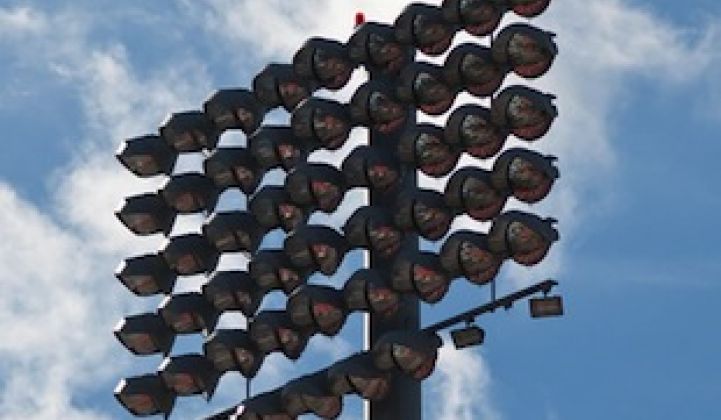The Department of Energy did not waste any time in taking a first step toward fulfilling last week’s commitment to issue long-overdue energy-savings standards: yesterday, DOE issued a proposed rule for metal halide lamp fixtures.
While metal halide lamps aren’t a common household name, chances are you’ve seen them before. Metal halides are the bright white lights typically housed in dome shaped fixtures that are common in high ceiling applications, such as gymnasiums, big-box stores, and warehouses, as well as in outdoor lighting fixtures.
According to DOE’s analysis, the proposed standards would save about one quad of energy cumulatively over 30 years of purchases, which is equivalent to about 1 percent of the annual energy use in the United States. DOE also estimates that the rule would save consumers a net $3 billion over the same period, and because less dirty power generation is needed to operate the lights, it would reduce carbon pollution emissions by a cumulative 15 million to 17 million metric tons by 2030, equivalent to taking over 3 million cars off the road for a year. This is a "down payment" toward meeting the commitment in the president’s new Climate Action Plan to achieve 3 billion metric tons of carbon reduction through efficiency standards by 2030. (For a more detailed description on what’s in the proposed standards, see ASAP’s blog here.)
Metal halides are one of four products for which DOE has currently missed legal deadlines. The final rule deadline for metal halide lamp fixtures was January 2012 and the proposed rule has been under review by the White House Office of Information and Regulatory Affairs (OIRA), which reviews regulatory standards before they become final and has caused much of the delay -- in this case, for more than sixteen months. Last week, the Department of Energy sent a letter to New York’s Attorney General and others committing to issue proposed rules for three of the four delayed standards this month and the fourth in November. Yesterday’s proposed rule is the first of these three.
It’s great that it looks like DOE and OIRA are serious about getting the efficiency standards program back on schedule that we know saves money and energy while reducing harmful carbon dioxide emissions. We’re looking forward to reviewing the proposed rule in detail, as well as the proposed rules for commercial refrigeration and walk-in coolers and freezers promised sometime this month. DOE has committed to finalizing the proposed rule for metal halide lamp fixtures by January 2014 (two years late, alas) and DOE and OIRA will have to remain diligent to meet this deadline. We’ll be watching carefully to make sure that these standards come out by the dates on this new schedule.
***
Meg Waltner is an Energy Efficiency Advocate at the Natural Resources Defense Council. This piece was originally published at NRDC's Switchboard blog and was reprinted with permission.



